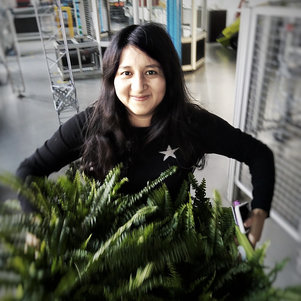Plants can uptake gaseous pollutants and improve home comfort, but does this also mean that active plant systems improve overall indoor air quality? The quality improves, but test subjects do not prefer it to unfiltered air, discovered Tatiana Armijos Moya in her PhD research.
The PhD candidate furnished two identical rooms in the SenseLab in TU Delft with brand new carpeting with a relatively strong smell. An active plant-based system was placed in one of the rooms, to evaluate in time how people perceived the air coming out of the two rooms. The majority of subjects chose for air that came from the room that had not been purified by plants. “That was quite a surprise”, says Armijos Moya. “Because most people like to be surrounded by plants.”
She came up with the idea for the trial because research has shown that plants can capture pollutants. NASA first demonstrated this already in 1989. Based on this principle of botanical biofiltration, Armijos Moya conducted several lab experiments to find the right configuration to build an active plant system. For this she placed 30 ferns in racks and placed mechanical ventilation behind every fern. The function of the fans was to force the polluted air to go through the plant and substrate and then release filtered air into the room.
The choice for ferns was based on the results of her previous lab experiments at WUR that proved their air-cleaning capacity. In these experiments she also arrived at the selection of the ideal substrate. Wet potting soil outperformed activated carbon, but expanded clay granules proved more suitable for an active plant system. These have a cleaning capacity and physical properties that allow the biofiltration proces without the use of much energy.
Scent
Test subjects found the smell from the room with plants “more intense”, but also “less acceptable”. How come? “Probably because they couldn't identify the scent”, says Armijos Moya. “What is unknown is rejected”.
She admits to being a little disappointed, because measurements she made in her experiment at Wageningen University confirmed that the plants do their air-purifying work. The amount of formaldehyde and CO2 in this test chamber decreased noticeably.
It is not possible to have a standard home or office space meet the minimum ventilation requirements set by the Building Decree with plants alone. According to her calculations, without mechanical ventilation 42 plants per square meter are needed. However, she does see opportunities for active systems. “They are much more efficient than passive ones and require fewer plants,” says Armijos Moya. “Plants also have a positive psychological effect and ensure a better heat and moisture balance. Active plant systems thus promote the complete personal living environment”.
Published: January 2022
More information

